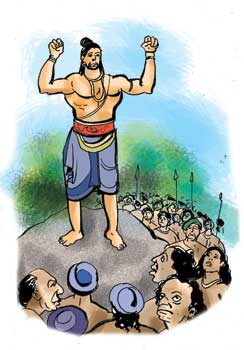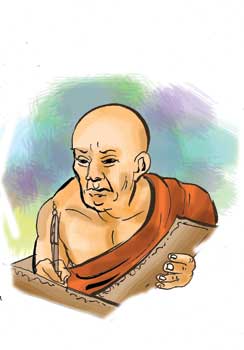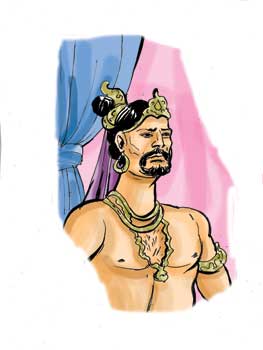
The Dry Zone losses its glory~This article is part of a continuing series on the ‘Mahavamsa,’ the recorded chronicle of Sri Lankan history~
1. Gradually the dry zone turned into jungle land. The temples, palaces and all palatial buildings were ruined. Tanks, canals and bunds were destroyed. As this area was deserted, there is no mention of this area in any of the inscriptions of the period. The chronicles too remain silent about this period. Since 1215 AD, this area had gone into oblivion. It is the South-Western Wet Zone and the Malaya-rata that is spoken of, both in inscriptions and chronicles. They were areas that were colonized in double quick time. Temples, pirivenas and other buildings of importance, sprang up here.
3. Just as some Buddhist priests fled to foreign lands in the 11th century, because of the suffering under the Cholas, this time too, some priests went to India and Burma. Even the forest hermitage of Dimbulagala felt Magha's influence. This is a religious centre that has existed for almost 13 centuries, from the time of King Valgamba. 4. This was a religious centre that flourished under every generation. It is for the first time in its history, that it was abandoned. The monks who resided here, migrated to the South-West. Among them, some priests including Ven. Deepankara Nayaka Thera, went to Yapahuwa. By this time, Yapahuwa had become a separate unit, ruled by a commander named Subha. He was a brave leader.
6. All these monks stayed in Dambadeniya. Dambadeniya then was the area where most of the Sinhala inhabitants lived. There were other areas as well, where the Sinhala people were powerful. A prince named Buwanekaba was spreading his power in Govindamala. This prince was an 'Adipada'. This Govindamala area is known as the 'Mahavadi rata Korale,' in the Uva Province. A commander named Sanka became powerful in the area known as Gandeniya of Gangadroni. This included Minipe and its neighouring villages. 7. Magha's erstwhile enemy was the commander Subha of Yapahuwa. He made a huge mountain named 'Subha Pabbata,' his centre of power. He was able to suppress the spread of Magha's power. Beyond that, they could not stage a protest. They looked after the safety of their areas of power but were unable to rise as national and religious leaders. 8. It was Prince Vijayabahu who at least in some measure, could rise as a national and religious leader. His area of rule was Dambadeniya, in the Kurunegala district. Those days it was called 'Jambudroni.' This prince is well known as Vijayabahu III. |
|
||||||
|| Front
Page | News | Editorial | Columns | Sports | Plus | Financial
Times | International | Mirror | TV
Times | Funday
Times || |
| |
Reproduction of articles permitted when used without any alterations to contents and a link to the source page.
|
© Copyright
2008 | Wijeya
Newspapers Ltd.Colombo. Sri Lanka. All Rights Reserved. |

 2. The Jetavana temple was badly affected by the cruel rule of Magha. The Chief-Priest (Sangha-Nayaka) of the temple suffered a lot. He, along with the other monks, gave up all temple property. They took the Tooth Relic and all other relics and fled. The Tooth Relic was hidden in Kotmale. Some priests went to Malaya-rata, whereas many more went to the South. A few settled down in the North-West region.
2. The Jetavana temple was badly affected by the cruel rule of Magha. The Chief-Priest (Sangha-Nayaka) of the temple suffered a lot. He, along with the other monks, gave up all temple property. They took the Tooth Relic and all other relics and fled. The Tooth Relic was hidden in Kotmale. Some priests went to Malaya-rata, whereas many more went to the South. A few settled down in the North-West region.  5. This commander Subha, erected a forest hermitage at Walasgala (Asgiriya) and donated it to the 'Vanavasi' bikkhus. Scholars are of the opinion that the Kandy Asgiriya chapter of monks, are the descendents of this line of bikkhus. A student priest of Venerable Vanaratana Buddhawamsa Thera was the chief of another group of monks, who went from Dimbulagala. He was Venerable Dimbulagala Medhankara Thera.
5. This commander Subha, erected a forest hermitage at Walasgala (Asgiriya) and donated it to the 'Vanavasi' bikkhus. Scholars are of the opinion that the Kandy Asgiriya chapter of monks, are the descendents of this line of bikkhus. A student priest of Venerable Vanaratana Buddhawamsa Thera was the chief of another group of monks, who went from Dimbulagala. He was Venerable Dimbulagala Medhankara Thera.